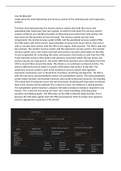Unit 9A BIOLOGY
Understand the interrelationship and nervous control of the cardiovascular and respiratory
systems
This flow chart demonstrates the human nervous system that hold the nerves and
specialised cells (neurones) that carry signals to and from the brain.The nervous system
consists of Nerves are cylindrical bundles of fibres that start at the brain and central cord
that reach out like branches all over the body. The nervous system has two main
components: the central nervous system (CNS) and the peripheral nervous system (PNS).
The PNS works with all the nerves (axons/bundles of axons from nerve cells or from nerve
cells or neuron) that connect with the CNS to the organs, limbs and skin. The PNS is spilt into
two sections: the somatic nervous system and the autonomic nervous system. The somatic
nervous system carry’s the motor neurones and sensory neurones information to the CNS,
its also responsible for controlling the motor and sensory information to and from the CNS,
it also transmits sensory information and voluntary movement which the two motor and
sensory neuron are a big part of. The motor (efferent) neurones carry information from the
CNS to muscle fibres around the body. This allows us to contribute in physical activity. The
sensory (afferent) neurons takes in sensory information and sends it to the CNS. The
autonomic nervous system is part of the peripheral nervous system that regulates
Automatic movements such as blood flow, heartbeat, breathing and digestion. The ANS is
spilt into two parts, parasympathetic system and sympathetic system. The parasympathetic
system helps maintain normal body functions and conserve physical resources, for example,
if the body feels threatened, heart rate will slow down, breathing will slow down and blood
flow to the muscles will be reduced; this is done to return our bodies to a resting position.
The sympathetic system however, prepares the body to disburse energy to respond to any
threats. This is done by increasing our heart rate, heavy breathing, activating sweat
secretion and dilating pupils. The PNS relies on the CNS to help the body function, this is
because the CNS takes signals from the PNS and processes them to create new signals to
execute appropriate responses to the stimuli.
, General structure and function of sensory, relay and motor neurones as well as role of glial
cells
Sensory, relay, and motor neurons are the three primary groups of neurons. Depending on
where it is in the body and what role it plays in the nervous system, each of these neurons
has a different function. Glial cell is a type of nerve cell that supports and protects neurons,
this makes Glia is comparable to the staff at the electric company who ensure that wires are
routed correctly, maintain the wires, and remove damaged wires.
Picture from: https://www.thesciencehive.co.uk/new-page-2
, Action potential
A nerve impulse is a quick
reversal of electrical charge
through a resting neuron's
membrane. An action
potential is the reversal of
charge. When a neuron
receives a chemical signal
from another cell, the
process begins. The signal
causes sodium ion channel
gates to open, allowing
positive sodium ions to enter
the cell. As a consequence,
the cell's interior becomes
positively charged. Ions pass through the membrane only at the nodes between parts of
myelin in neurons with myelin sheaths. In response, rather than spreading smoothly across
the entire axon membrane, the action potential hops from node to node. Because of this, It
travels at a faster rate. A synapse is the point where an axon terminal meets another cell.
The axon terminal and the other cell are separated by a synaptic cleft, which is a narrow
space. The axon terminal releases molecules of a chemical called a neurotransmitter when
an action potential hits it. Neurotransmitter molecules cross the synaptic cleft and bind to
receptors on the other cell's membrane. If the other cell is a neuron, this allows the other
cell to fire an action potential.
An action potential starts when depolarisation increases the membrane voltage to pass
threshold value (-55 mV). Here the Na+ channels open making way for sodium ions to go
into the cell. The rush of sodium ions increases membrane potential to around 50mV
(depolarisation along the neurone). After a while, the sodium channels shut down, stopping
the influx of sodium. Then a number of voltage gated potassium channels open and the
potassium to exit the cell down the electrochemical gradient(repolarisation) which
decreases the membrane potential back to its normal resting state. The hyperpolerisation is
where the voltage gated potassium channels stay open for just a while which makes the
membrane potential more negative than resting potential for a few seconds. Next, the gates
close and the membrane stays at resting potential, this is where there’s no stimulus and NA
K pump maintains the restring potential. Finally, sodium channels return to their normal
state. The cycle can then repeat itself again.
Mylelinated and non-myelinated neurones
Myelin is a sheath or insulating coating that forms around nerves in the brain and spinal
cord. Protein and fatty substances make up its composition.
Electrical impulses can move rapidly and efficiently along nerve cells thanks to this myelin
sheath. This is because Nodes of Ranvier are periodic breaks in the myelin sheath. The
impulse will go much faster by hopping from node to node than if it were to travel the
entire length of the nerve fibre. These impulses slow down as myelin is weakened. Multiple
sclerosis, for example, may be caused by this. Neurones have myelinated sheaths because
myelin has a low capacitance and a high electrical resistance, it can act as an insulator. As a




